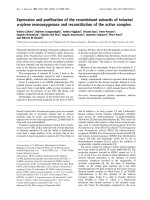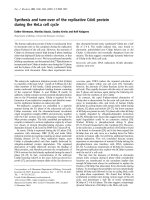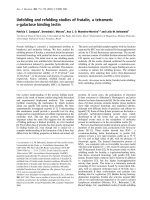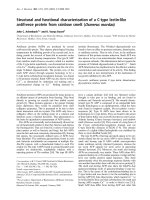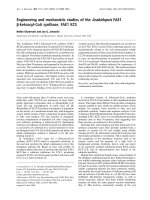Báo cáo y học: "Operative and early results of coronary artery bypass grafting in female patients in different body mass indexes" pdf
Bạn đang xem bản rút gọn của tài liệu. Xem và tải ngay bản đầy đủ của tài liệu tại đây (443.07 KB, 6 trang )
RESEARC H ARTIC LE Open Access
Operative and early results of coronary artery
bypass grafting in female patients in different
body mass indexes
Hilmi Tokmakoglu
Abstract
Background: Female gender has been reported to be an independent risk factor for coronary artery bypass
grafting (CABG) in European System for Cardiac Risk Evaluation. The effect of the body size on the CABG outcome
is less clear. There is ongoing debate about obesity as a risk factor for adverse outcomes after cardiovascular
procedures. The goal of this retrospective study is to evaluate the in hospital and early postoperative outcomes in
severe obese, obese and normal-slightly obese female patients after CABG.
Methods: In a four year period a total of 427 female patients underwent isolated CABG under cardiopulmonary
bypass. The patients were allocated into three groups according to the Body Mass Index (BMI) as follows; group 1:
severe obese patients; BMI > 35, group 2: obese patients; 30≤BMI≤35, group 3: normal-slightly obese patients; BMI
<30
Results: The patients in group 3 were older than the group1 and group 2 (65,6 ± 8,3 year vs 63,01 ± 8,0 and 63,57
± 8,4 year p < 0,05). In group 1 diabetic patients were more than in group 2 and group 3 respectively (54,4% vs
43,4% and 40%, p < 0,05). Urgent operation was more in group 1 than in group 2 and 3 respectively (37,6% vs
17,2% and 21,2% p < 0,05). The patients in group 3 had significantly greater postoperative drainage at 24 h
compared with values in group 1 and group 2 (647 ± 142 ml vs. 539 ± 169 ml and 582 ± 133 ml, p < 0,05).
Mortality rate in group 1 was 0,8%, 0% in group 2 and 1,2% in group 3 respectively. Wound problem has occured
in 41 patients (9,6%).The percentage of postoperative wound problems was higher in group 1 but did not show
statiscially difference. Following discharge a total of 43 (10,1%) patients re-hospitalized within 30 days. Re-
hospitalization rate was 16,1% in group1, 9,8% in group 2 and 6,5% in group 3 (p < 0,05).
Conclusion: This study may give an aspect for evaluations of the inhospital-early mortality and morbidity after
CABG in female patients in different BMI. Severe obesity is not a risk factor in-hospital mortality in female patients.
However, severe obese female patients appear to have more wound problems and re-hospitalization rate after
CABG compared to obese and normal-slightly obese patients.
Background
Female gender has been reported to be an independent
risk factor for coronary artery bypass grafting (CABG)
in European System for Cardiac Risk Evaluation [1]. In
comparison to male patients female patients undergoing
CABG have more comorbid risk factors such as; older
age, smaller body size, higher prevalance of hype rten-
sion, diabetes mellitus, unstable anjina pectoris, smaller
size of coronary arteries. Numerous studies have
demonstrated increased hospital mortality after CABG
in female patients On the other hand studies suggest
that female patients clearly benefit from CABG [2-4].
TheeffectofthebodysizeontheCABGoutcomeis
less clear. There is ongoing debate about obesity as a
risk factor for adverse outcomes after cardiovascular
procedures [5-7]. Some studies have documented that
obesity is not a risk factor for adverse outcomes [8-10]
whereas other studies have conclud ed that extreme obe-
sity is a significant independent predictor for adverse
outcomes after CABG [11,12].
Correspondence:
Cardiovascular Surgery Department, Ozel Tekden Hastanesi Kocasinan-
Kayseri, Turkey
Tokmakoglu Journal of Cardiothoracic Surgery 2010, 5:119
/>© 2010 Tokmakoglu; licensee BioMed Central Ltd. This is an Open Access article distributed under the terms of the Creative Commons
Attribution License ( which permits unre stricted use, distribution, and reproduction in
any medium, provided the original work is properly cited.
The goal of this retrospective study is to evaluate the
in hospital and early postoperative outcomes in severe
obese, obese and non-obese female patients after CABG.
Methods
Patients
In a four year period a total of 427 female patients
underwent isolated CABG under cardiopulmonary
bypass (CPB). Patients who underwent concomitant pro-
cedures such as; valve operation, carotid endarterect-
omy, were excluded.
Data collection and definitions
Preoperative, intraoperative and postoperative variables
and complications were collected retrospectivly from
hospital database. The variables defined as follows; dia-
betes mellitus (DM); diet-controlled, oral therapy or
insulin dependent DM, hypertension; history of hyper-
tension necessitating medical treatment, chronic
obstructive pulmonary disease; predicting of forced
expiratory volume in 1 sec or diffusion capacity less
than 75% at pulmonary functional test, vascular dis-
ease; peripheral, abdominal vascular pathology or opera-
tion, rhythm; preoperat ive sinus rhythm, ejection
fraction ≤ 40%; determined with preoperative transthor-
acic echocardiography and named as poor ventricular
function, pulmonary hypertension; pulmonary artey
pressure ≥ 30 mmHg determined with preoperative
transthoracic echocardiography, creatinin level; blood
creatinin level preoperatively and 1st postoperative day,
thyroid disease; hypothyroidism or hyperthyroidism
necessitating therapy and all patient’sthyroidfunctions
were measured preoperatively, left main coronary
artery disease (LMCA); LMCA stenoses ≥ 70 , preo-
perative myoc ardial infarction (MI); history of MI
before the operation, operative status; elective: stabil
cardiac function and operation is more than 1 day fol-
lowing diagnosis, urgent; the operation that occurred
within 24 h of coro nary catheterisation because of criti-
cally vessel lesion with unstable symptoms, emergency;
operation is within the hours for evolving infarction,
ischemia not responding to medical therapy, cardiogenic
shock or very critically LMCA and right coronary artery
disease, inotrophic support and/or IABP; intraopera-
tive and/or postoperative inotrophic - IABP support due
to haemodynamic instability, perioperative myocardial
infarction; anewQwaveandriseinCPK-MB%≥
10%, re-exploration; re-operation for bleeding, tampo-
nade, neurological complications; postoperative cere-
brovascular accidents and/or transient ischemic attack,
pulmonary complications; re-entubation, pulmonary
infection, severe athelect azia necessitating intensive
fizyotherapy postoperatively, wound problems; consist
in-hospital and within 30 days follo wing discharge;
sternotomy and saphenous incision problems were
seperately defined as follows; sternotomy wound pro-
blems; superficial infections, deep wound-mediastinal
involvement and sternal dehiscence, saphenous incision
problems; wound healing problems requiring surgical
debr itman, mortality; all mortality during postoperative
hospital stay, re-hospitalization; following discharge
re-hospitalization within 30 days due to pulmonary
emboli, deep venous thrombosis, plevral effusion requir-
ing thorasentesis, heart failure, arrhytmia, severe creati-
nin elevation and wound problems, Body Mass Index
(BMI); calculated as weight (kg)/height squared (m2).
The patients were allocated into three groups according
to the BMI as follows;
Group 1: Severe obese patients; BMI > 35
Group 2: Obese patients; 30 ≤ BMI ≤
35
Group 3: Normal-slightly obese patients; BMI < 30
Surgical technique
All patients were operated using standart CPB tecnique,
aortic and two stage right atrial cannulation, systemic
hypothermia (28-32 C). Internal thoracic artery and
saphenous vein were harvested with conventional tech-
nique. Following cross-clamping of the aorta the heart
was arrested using intermittant cold blood cardioplegia
antegradely and retrogradely, continued with in every 20
min, and finally warm blood cardioplegia was adminis-
tered before releasing the aortic cross-clamp. The l eft
internal thoracic artery (LITA) was the graft of choice
for left anterior descending coronary artery (LAD) in
patients and saphenous vein grafts (SVG) for the ot her
anastomosis. After distal anastomoses, proximal anasto-
moses were done during reperfusion with an partial aor-
tic occluding clamp. During the CPB hematocrit levels
were maintained above 20%. Also in all patients efforts
were made to ensure perioperative and postoperative
blood glucose levels in the range of 150 to 200 mg/dL.
After routine closure of the chest, continuous suction
(10mmHg)wasappliedtothedrains,whichwere
milked and stripped at 30-min intervals to ensure tube
patency. Chest tubes were removed the following day
when the drainage was less than 20 ml/h for consecutive
4 h. All patients were extubated in the intensive care
unit (ICU) after establishment of hemodynamic stability.
After ICU period, regulation of blood glucose leve ls
were done by internal medicine departmant.
Statistical analysis
Data evaluation was carried out using a computer statis-
tical package (SPSS 15.0 for Windows, SPSS, Inc., Chi-
cago, IL) and are expressed as means ± SD or as
frequencies or percentages. The relationships between
Tokmakoglu Journal of Cardiothoracic Surgery 2010, 5:119
/>Page 2 of 6
independent preoperative and operative variables and
postoperative outcome measures were investigated by
One-way Anova test or c
2
test for categorical variables.
A P value of <0.05 was considered significant.
Results
Preoperative variables are listed in Table 1. There were
125 patients in group 1, 122 patients in group 2 and
170 patients in group 3. The mean BMI was 37,8 ± 2,6
ingroup1,32,0±1,3ingroup2and26,7±2,5in
group3 respectively.
The patients in group 3 were older than the group1
and group 2 (65,6 ± 8,3 year vs 63,01 ± 8, 0 and 63,57 ±
8,4 year p < 0,05). In group 1 diabetic patients were
more than in group 2 and group 3 respectively (54,4%
vs 43,4% and 40%, p < 0,05). The remaining factors of
hypertension, smoking, cholesterol level, the percantage
of chronic obstructive pulmonary disease (COPD), per-
ipheral vascular disease, the percantage of sinus rythm,
previous MI, left main coronary arte ry disease (LMCA),
the extension of vessel disease, mean ejection fraction-
percantage of EF % ≤ 40, pulmonary hypert ension
(PHT), mean preoperative and 1 st postoperative day
creatinin levels showed no statistical differences between
the three groups.
Operative and early postoperative variables are listed
in Table 2. Urgent operation was more in group 1 than
in group 2 and 3 respectively (37,6% vs 17,2% and 21,2%
p < 0,05). Also elective surgery was more in group2 and
3 than in group 1 (75,4% and 75,9% vs 58,4% p < 0,05).
The other parameters; mean CABG number, percantage
of LITA usage, mean aortic cross clamp time (ACC),
cardiopulmonary bypas s time (CPBT), percantage of
inotrophic support, mean extubation and intensive care
unit (ICU) time did not differ beetween the groups. The
patients in group 3 had significantly greater postopera-
tive drainage at 24 h compared with values in group 1
and group 2 (647 ± 142 ml vs. 539 ± 1 69 ml and 582 ±
133 ml, p < 0,05). Four patients in group 3 was revised
due to bleeding and/or tamponade whereas none in
group 1 and 2. Also occurence of atrial fibrillation (AF),
perioperative MI, neurological and pulmonary complica-
tions did not differ between the groups. The overall hos-
pital mortality rate was 0,7%. Mortality rate in group1
was 0,8%, 0% in group2 and 1,2% in group3 respectively.
Wound problem has occured in 41 patients (9,6%). The
percent age of postoperative wound problems was higher
ingroup1butdidnotshowstatisciallydifference.
Following discharge a total of 43 (10,1%) patients
re-hospitalized within 30 days due to reasons mentioned
Table 1 Preoperative variables
Variable Group 1 (n:125) Group 2 (n:122) Group 3 (n:170) p-value
Age, (year) 63,01 ± 8,0 63,57 ± 8,4 65,6 ± 8,3 0,015
BMI 37,8 ± 2,6 32,0 ± 1,3 26,7 ± 2,5
DM 54,4% 43,4% 40% 0,043
Hypertension 65,6% 62,3% 57,6% 0,3
Smoking 7,2% 11,5% 7,6% 0,4
Cholesterol(mg/dl) 211,2 ± 47,3 209 ± 44,5 208,5 ± 50,2 0,8
COPD 24,8% 13,9% 21,8% 0,08
PVD 4% 3,3% 4,7% 0,8
Sinus rythm 99,2% 99,1% 98,8% 0,5
Thyroid disease
Hypothyroidism 8(6,4%) 6(4,9%) 10(5,9%) 0,8
Hyperthyroidism 3(2,4%) 4(3,3%) 6(3,5%) 0,8
PreMI 29,6% 18,2% 22,4% 0,09
Vessel disease
1 vessel 12% 9,8% 11,8% 0,98
2 vessel 29,6% 30,3% 29,4% 0,98
3 vessel 58,4% 59,8% 58,8% 0,98
LMCA 8,8% 8,2% 6,5% 0,7
EF%, mean ± SD 54,3 ± 10,8 55,9 ± 9,6 56,5 ± 10,3 0,17
EF%≤ 40 16,8% 9,8% 10,6% 0,17
PHT (mmHg,%) 16% 14,8% 20,6 0,37
Creatinin1 (mg/dl) 0,89 ± 0,19 0,90 ± 0,15 0,87 ± 0,17 0,26
Creatinin 2 (mg/dl) 1,1 ± 1,2 1,0 ± 0,3 0,95 ± 0,28 0,15
COPD; chronic obstructive pulmonary disease, PVD; peripheral vascular disease, PreMI; preoperative MI, PHT; pılmonary hypertension, Creatinin1; preoperatively, 2;
postoperatively creatinin level
Tokmakoglu Journal of Cardiothoracic Surgery 2010, 5:119
/>Page 3 of 6
above. Re-hospitalization rate was 16,1% in group1, 9,8%
in group 2 and 6,5% in group 3 (p < 0,05).
Discussion
Cardiovascular disease is leading cause of morbidity and
mortality for women in developed and developing coun-
tries. There is considerable evidence that female gender
carry a higher CABG mortality when compared with the
male patients [13-15]. On the other hand obesity is con-
sidered to be a major risk factor in patients undergoing
CABG. With the increasing of BMI also comorbidty
increases [16,17]. There are major differences in the risk
profile of female patients compared with the profile of
male patients [18,19]. The great majority of studies
show that diabet es is 40% to 50% more common in
female patients than male patients undergoing CABG
[20,21]. In this study diabetes is found to be 45,3% in
totally whereas 54,4% in severe obese patients. It is well-
known that t here is a clear association of diabetes with
adverse postoperative outcome in surgical patients.
Despite the usage of prophylactic antibiotics, sternal
wound infections are associated high mortality and mor-
bidity. In our severe obese patients sternal superficial
infections and sternal dehisence were more common
but not statistically significant than the other groups.
Some studies were emphasised that hyperglycemia in
the first 2 postoperative days is the single most impor-
tant predictor of mediastinitis after cardiac surgery and
blood glucose level must be maintained below 200 mg/
dL [22,23]. As mentioned before in our p atients special
efforts were made to ensure perioperative and post-
operative blood glucose levels in the range of 150 to 200
Table 2 Operative and early postoperative variables
Variable Group 1 Group 2 Group 3 P-value
Operative status %
Emergency 5,6 6,6 3,5 0,4
Urgent 37,6 17,6 21,2 0,0001
Elective 58,4 75,8 75,9 0,002
CABG (n) 2,98 ± 0,89 2,98 ± 0,78 2,95 ± 0,79 0,93
LITA usage% 89,6 90,2 89,7 0,3
ACC (min) 38,3 ± 12,0 37,8 ± 10,1 37,7 ± 10,5 0,71
CPBT (min) 57,6 ± 16,9 56,9 ± 13,6 57,0 ± 14,6 0,82
Inotrophic support % 20 12,3 18,9 0,21
Extubation time(hour) 11,7 ± 3,4 11,7 ± 3,5 12,0 ± 4,4 0,62
ICU time(hour) 25,7 ± 3,6 27,7 ± 24,3 26,7 ± 16,0 0,54
Drenaige (ml) 539 ± 169 582 ± 133 647 ± 142 0,0001
Revision 0 0 4(2,6%) 0,053
AF % 24 20,5 20,0 0,68
Perioperative MI 3(2,4%) 3(2,5%) 5(2,9%) 0,9
NC % 0,8 0 0,6 0,63
Pulmonary compl.% 4,8 1,6 2,4 0,41
Wound problems 16(12,8%) 11(9%) 14(8,2%) 0,40
Sternotomy
Superficial 4(3,2%) 3(2,5%) 4(2,4%) 0,89
Deep 2(1,6%) 1(0,8%) 2(1,2%) 0,85
Dehisence 4(3,2%) 3(2,5%) 3(1,8%) 0,72
Saphenous 6(4,8%) 4(3,3%) 5(2,9%) 0,67
Mortality 1(0,8%) 0 2(1,2%) 0,49
Re-hospitalization 20(16,1%) 12(9,8%) 11(6,5%) 0,02
DVT 300
DVT+PE 110
Plevral effusion 213
Heart failure 210
Arrythmia 221
Creatinin elevation 221
Wound problems 8 56
ACC; aortic cross clamp time, CPBT; cardiopulmonary bypass time, ICU; intensive care unit, AF; atrial fibrillation, NC; neurological complication, DVT; deep venos
thyrombosis, PE; pulmonary emboli
Tokmakoglu Journal of Cardiothoracic Surgery 2010, 5:119
/>Page 4 of 6
mg/dL with the using of continuous intravenous insulin
infusions.
Hypothyroidism is associated with impaired ventricu-
lar contractility and in female patients there is a higher
incidence of hypothyroidism undergoing CABG [24]. In
the study of Zindrou and colleagues they found a high
mortality rate (16,7%) in female patients requiring thyr-
oid replacement therapy whereas not in male patients
[25]. In our clinic all patient’ sthyroidfunctionswere
measured preoperatively and hypothyroidic patients
were maintained in a euthyroid state before the opera-
tion. In non-elective status patients therapy was begun
before the operation and contiuned following operation.
The use of at least one LITA confers both in-hospital
and long-term improvement in CABG mortality [26,27].
However usage of LITA as a conduit in female patients is
only 60%-75% of cases [28,29]. This is significantly less
thanLITAusageinmalepatients. Actually there is no
objective reason to use the LITA less ferquently in females
than the males. Perhaps the presence of a soft friable ster-
num that predisposes sternal dehisence is a valid reason to
avoid use of LITA [30]. In the s tudy of Aldea and collea-
gues LITA was us ed in 91% of female patients and found
no gender differences in operative mortality [31].
In most series there is a higher rate of non-elective
CABG in female patients [28,31]. Likewise in our study
the rate of non-elective surgery was 29,2% in all patients
whereas statiscially higher in group 1 than the other
groups. Also in other studies it was emphasised that use
of LITA is safe when urgent and emergency operations
are being performed [32,33]. In our study use of LITA
as a conduit was found 89,6% in severe obese group
even percentage of urgent surgery was high.
Some studies found a significant reduction for the risk
of postoperative bleeding in obese patients [34,35]. Like-
wise in our study the amount of bleeding and re-
exploration rate was less in obese grups than the non-
obese grup.
Atrial fibrillation (AF) is a frequent e vent after CABG
with an incidence of 15-40%. It may result in hemody-
namiccompromiseduringthepostoperativeperiod.
Ther e are some reports saying AF are seen in high BMI
score patients [36,37]. In our patients there was no sig-
nificant difference between the three groups
We did not find a significant difference ICU time,
creatinin levels, neurological complications and mortal-
ity rates between the three groups.
Obesity alters the pulmonary function leading to an
increase in functional residual capacity, and a decrease
in vital capacity and maximum voluntary ventilation
[38]. In addition, anaesthetic drugs that are revealed
from the fat tissue may prolong the entubation time.
Also patients with low BMI have remarkable haemodilu-
tion, fall in the oncotic pressure during CPB and this
may lead excess fluid extravasation [39]. In this study
we did not find a significant difference for extubation
time between the groups. Hovewer postoperatively pul-
monary complication was more common in group1 but
showed no statiscially difference.
Readmission following discharge is an impor tant
adverse outcome of CABG surgery. Hannan El et al.
examined the frequency and causes of CABG surgery
readmissions and in their study they found 15,3% read-
misionswithin30daysfollowing discharge. Also they
found female gender is a risk factor of readmission after
CABG [40]. In our study a total of 43 (10,1%, mostly in
group1) patients readmitted and re-hospitalized follow-
ing discharge.
Limitations of the study
Thisstudywasdoneonaretrospectiveseriesfroma
single institution and also gives only in-hospital and
early postoperative period outcomes. Further comple-
mentary studies with higher number of patients and
including early, mid-term, long-term results in contem-
porary methods are warranted.
Conclusion
This study may give an aspect for ev aluations of the
inhospital-early mortality and morbidity after CABG in
female patients in different BMI. Female gender and
also severe obesity is not a risk factor in-hospital mor-
tality. However, severe obese female patients appear to
have more wound problems and re-hospitalization rate
after CABG compared to obese and non-obese patients.
Authors’ contributions
HT: Performed operations, wrote manuscript.
Author read and approved the final manuscript.
Competing interests
The authors declare that they have no competing interests.
Received: 29 September 2010 Accepted: 26 November 2010
Published: 26 November 2010
References
1. Roques F, Nashef SA, Michel P, Gauducheau E, de Vincentiis C, Baudet E,
et al: Risk factors and outcome in European cardiac surgery: analysis of
the EuroSCORE multinational database of 19030 patients. Eur J
Cardiothoracic Surg 1999, 15:816-822.
2. Loop FD, Golding LR, MacMillan JP, Cosgrove DM, Lytle BW, Sheldon WC:
Coronary artery surgery in women compared with men: analysis of risk
and long term results. J Am Coll Cardiol 1983, 1:383-390.
3. Gardner TJ, Horneffer PJ, Gott VL, Watkins L Jr, Baumgartner WA,
Borkon AM, et al: Coronary artery bypass grafting in women. Ann Surg
1985, 201:780-784.
4. Herlitz J, Brandrup-Wognsen G, Karlson BW, Sjoland H, Karlsson T, Caidahl K,
et al: Mortality, risk indicators of death, mode of death and symptoms of
angina pectoris during5 years aftercoronary artery bypass grafting in
men and women. J Intern Med 2000, 247 :500-506.
5. Jin R, Grunkemeier GL, Furnary AP, Handy JR Jr: Is obesity a risk factor for
mortality in coronary artery bypass surgery? Circulation 2005,
111:3359-3365.
Tokmakoglu Journal of Cardiothoracic Surgery 2010, 5:119
/>Page 5 of 6
6. Pan W, Hindler K, Lee V, Vaughn W, Collard CD: Obesity in diabetic
patients undergoing coronary artery bypass graft surgery is associated
with increased postoperative morbidity. Anesthesiology 2006, 104:441-7.
7. Prabhakar G, Haan CK, Peterson ED, Coombs LP, Cruzzavala JL, Murray GF:
The risks of moderate and extreme obesity for coronary artery bypass
grafting outcomes: A study from The Society of Thoracic Surgeons’
Database. Ann Thorac Surg 2002, 74:1125-1131.
8. Moulton MJ, Creswell LL, Mackey ME, Cox JL, Rosenbloom M: Obesity is
not a risk factor for significant adverse outcomes after cardiac surgery.
Circulation 1996, 95(Suppl 9):1187-1192.
9. Fisher LD, Kennedy JW, Davis KB, Maynard C, Fritz JK, Kaiser G, Myers WO:
Association of sex, physical size, and operative mortality after coronary
artery bypass in the coronary artery study (CASS). J Thorac Cardiovasc
Surg 1982, 84:334-341.
10. Prasad US, Walker WS, Sang CTM, Campenella C, Cameron EWJ: Influence
of obesity on the early and long term results of surgery for coronary
artery disease. Eur J Cardiothorac Surg 1991, 5:67-73.
11. Prabhakar G, Haan CK, Peterson ED, Coombs LP, Cruzzavala JL, Murray GF:
The risks of moderate and extreme obesity for coronary artery bypass
grafting outcomes: A study from The Society of Thoracic Surgeons’
Database. Ann Thorac Surg 2002, 74:1125-1131.
12. Habib RH, Zacharias A, Schwann TA, et al: Effects of obesity and small
body size on operative and long-term outcomes of coronary artery
bypass surgery: a propensity-matched analysis. Ann Thorac Surg 2005,
79:1976-1986.
13. Carey JS, Cukingnan RA, Singer LKM: Health status after myocardial
revascularization: inferior status in women. Ann Thorac Surg 1995,
59:112-1117.
14. Edwards FH, Carey JS, Grover FL, Bero JW, Hartz RS: Impact of gender on
coronary bypass operative mortality. Ann Thorac Surg 1998, 66:125-131.
15. Hammar N, Sandberg E, Larsen FF, Ivert T: Comparison of early and late
mortality in men and women after isolated coronary artery bypass graft
surgery in Stockholm, Sweden1980 to 1989. J Am Coll Cardiol 1997,
29:659-664.
16. Health counsil of the Netherlands: Overweight and obesity. The Hague:
Health counsil of the Netherlands; 2003, Publication no. 2003/07.
17. Ray CS, Sue DY, Bray G, Hansen JE, Wasserman K: Effects of obesity on
respiratory function. Am Rev Respir Dis 1983, 128:501-506.
18. Zitser-Gurevich Y, Simchen E, Galai N, Mandel M: Effect of perioperative
complications on excess mortality among women after coronary bypass.
In J Thorac Cardiovasc Surg. Volume 123. The Israeli Coronary Bypass Graft
study(ISCAB); 2002:517-524.
19. Koch CG, Khandwala F, Nussmeier N, Blackstone EH: Gender profiling in
coronary artery bypass grafting. J Thorac Cardiovasc Surg 2003,
126:2044-2051.
20. Vaccarino V, Abramson JL, Veledar E, Weintraub WS: Sex differences in
hospital mortality after coronary artery bypass surgery. Circulation 2002,
105:1176-1181.
21. Woods SE, Noble G, Smith JM, Hasselfeld K: The influence of gender in
patients undergoing coronary artery bypass graft surgery: an eight year
prospective hospitalized cohort study. J Am Coll Surg 2003, 196:428-434.
22. Furnary AP, Zerr KJ, Grunkemeier G, Starr AS: Continuous intravenous
insulin infusion reduces the incidence of deep sternal wound infection
in diabetic patients after cardiac surgical procedures. Ann Thorac Surg
1999, 67:352-360.
23. Zerr KJ, Furnary AP, Grunkemeier GL, et al: Glucose control lowers the risk
of wound infection in diabetics after open heart operations. Ann Thorac
Surg 1997, 63:356-361.
24. Eagle KA, Guyton RA, Davidoff R, et al: ACC/AHA 2004 guideline update
for coronary artery bypass graft surgery: a report of the American
College of Cardiology/American Heart Association Task Force on
Practice Guidelines (Committee to Update the 1999 Guidelines for
Coronary Artery Bypass Graft Surgery). J Am Coll Cardiol 2004, 44:1146-54.
25. Zindrou D, Taylor KM, Bagger JP: Excess coronary artery bypass mortality
among women with hypothyroidism. Ann Thorac Surg 2002, 74:2121-2125.
26. Edwards FH, Clark RE, Schwartz M: The impact of internal mammary artery
conduits on operative mortality in coronary revascularization. Ann Thorac
Surg 1994, 57:27-32.
27. Leavitt BJ, O’Connor GT, Olmstead EM, et al: Use of the internal mammary
artery graft and in-hospital mortality associated with coronary artery
bypass grafting. Circulation 1998, 98:130.
28. Abramov D, Tamariz MG, Sever JY, et al: The influence of gender on the
outcome of coronary artery bypass surgery. Ann Thorac Surg 2000,
70:800-806.
29. Lawton JS, Brister SJ, Petro KR, Dullum M: Surgical revascularization in
women: unique intraoperative factors and considerations. J Thorac
Cardiovasc Surg 2003, 126:936-938.
30. Mickleborough LL, Takagi Y, Mariyama H, Sun Z, Mohamed S: Is sex a
factor in determining operative risk for aortocoronary bypass surgery?
Circulation 1995, 92(supp 1):1180-1184.
31. Aldea GS, Gaudiani JM, Shapira OM, et al: Effect of gender on
postoperative outcomes and hospital stays after coronary artery bypass
grafting. Ann Thorac Surg 1999, 67:1097-1103.
32. Cohn LH: Use of the internal mammary artery graft and in-hospital
mortality and other adverse outcomes associated with coronary artery
bypass surgery. Circulation 2001, 103:483-484.
33. Leavitt BJ, O’Connor GT, Olmstead EM, et al: Use of the internal mammary
artery graft and in-hospital mortality and other adverse outcomes
associated with coronary artery bypass surgery. Circulation 2001,
103:507-512.
34. Birkmeyer NJO, Charlesworth DC, Hernandez F, Leavitt BJ, Marrin CA,
Morton JR, Olmstead EM, O’Connor GT: Obesity and risk of adverse
outcomes associated with coronary artery bypass surgery. Circulation
1998, 97:1689-1694.
35. Engelman DT, Adams DH, Byrne JG, Aranki SF, Collins JJ, Couper GS,
Allred EN, Cohn LH, Rizzo RJ: Impact of body mass index and albumin on
morbidity and mortality after cardia surgery. J Thorac Cardiovasc Surg
1999, 118:867-873.
36. Moulton MJ, Creswell LL, Mackey ME, Cox JL, Rosenbloom M: Obesity is
not a risk factor for significant adverse outcomes after cardiac surgery.
Circulation 1996, 95(Suppl 9):1187-1192.
37. Koshal A, Hendry P, Raman SV, Keon WJ: Should obese patients not
undergo coronary artery surgery? Can J Surg 1985, 28:331-334.
38. Jenkins SC, Moxham J: The effects of mild obesity on lung function. Respir
Med 1991, 85:309-311.
39. Reeves BC, Ascione R, Chamberlain MH, Angelini GD: Effect of body mass
index on early outcomes in patients undergoing coronary artery bypass
surgery. J Am Coll Cardiol 2003, 42:668-676.
40. Hannan EL, Racz MJ, Walford G, et al: Predictors of readmission for
complications of coronary artery bypass surgery. JAMA 2003, 290:773-780.
doi:10.1186/1749-8090-5-119
Cite this article as: Tokmakoglu: Operative and early results of coronary
artery bypass grafting in female patients in different body mass
indexes. Journal of Cardiothoracic Surgery 2010 5:119.
Submit your next manuscript to BioMed Central
and take full advantage of:
• Convenient online submission
• Thorough peer review
• No space constraints or color figure charges
• Immediate publication on acceptance
• Inclusion in PubMed, CAS, Scopus and Google Scholar
• Research which is freely available for redistribution
Submit your manuscript at
www.biomedcentral.com/submit
Tokmakoglu Journal of Cardiothoracic Surgery 2010, 5:119
/>Page 6 of 6




